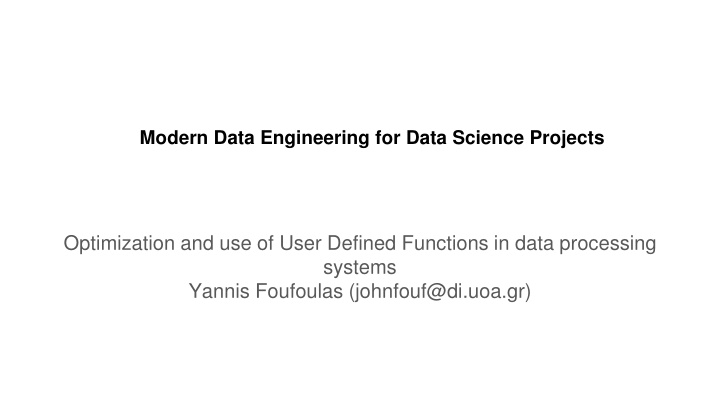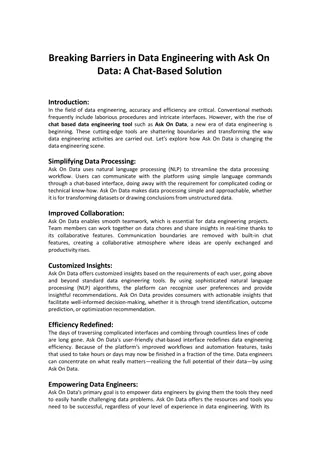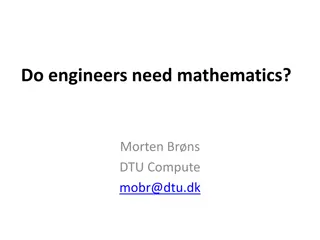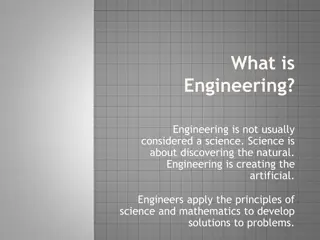
Modern Data Engineering for Data Science Projects Optimization
Learn about the optimization and use of user-defined functions in data processing systems for modern data engineering projects. Explore the challenges, types of UDFs, supported systems, Python booster technologies, performance issues, and expressiveness concerns.
Download Presentation

Please find below an Image/Link to download the presentation.
The content on the website is provided AS IS for your information and personal use only. It may not be sold, licensed, or shared on other websites without obtaining consent from the author. If you encounter any issues during the download, it is possible that the publisher has removed the file from their server.
You are allowed to download the files provided on this website for personal or commercial use, subject to the condition that they are used lawfully. All files are the property of their respective owners.
The content on the website is provided AS IS for your information and personal use only. It may not be sold, licensed, or shared on other websites without obtaining consent from the author.
E N D
Presentation Transcript
Modern Data Engineering for Data Science Projects Optimization and use of User Defined Functions in data processing systems Yannis Foufoulas (johnfouf@di.uoa.gr)
Motivation Modern data pipelines involve diverse data sources and complex processing tasks Typical applications in data science, data analytics, edge computing, etc. Many tools to assist developers design pipelines But: Very complicated ecosystem to execute pipelines Relational databases provide many hooks for processing and managing efficiently large data volumes Decades-old experience to provide optimized (distributed) query processing, efficient storage, acid properties etc. But: SQL provides limited expressive power UDFs to the rescue Extend the relational paradigm with syntactic and semantic support to capture complicated tasks and algorithms But: Impedance mismatch between their relational (SQL) evaluation and procedural (Python) execution Context switching overhead Data conversion overhead
User Defined Functions (UDFs) There are 3 standard types of UDFs as defined below: Row/scalar functions. They get one row in input and they return one value in output. Row functions are not placed after the `from` of a query but they can be placed anywhere else. Aggregate functions. They get one group of rows in input and they return one value in output. Aggregate functions are not placed after the `from` of a query but they can be placed anywhere else similarly to row/scalar functions. Table functions. They may get a subquery in input (e.g., this is not necessary as they may get any other parameter to import data from outside the db) and they return a result set. Table functions are placed after the `from` of a query.
Systems Python UDFs are supported in most data processing engines including: PySpark Dask PostgreSQL SQLite MonetDB Vertica DuckDB MongoDB etc.
Python booster technologies Systems based on translation of Python into an intermediate representation IR (e.g., Weld). Systems based on translation of Python libraries into SQL (e.g., Grizzly-sql) Python transpilers into C (Cython, Nuitka etc) Python tracing JIT compilers (PyPy, Tuplex)
UDF Performance Issues Black boxes for the optimizer, act as a barrier during query optimization Impedance missmatch between relational and procedural evaluation Context switches Intermediate result materializations Data copies and transformations Each small UDF runs in isolation -> not many optimization opportunities for the UDF compiler
UDF expressiveness issues Statically typed UDFs Limited to the three UDF types (scalar, aggregate, table) Stateless UDFs No polymorphism in most cases SQL was not initially designed to support pipelines with UDFs Cumbersome SQL queries in case of UDF chaining
UDF Fusion Fusion of UDFs with relational operators Elimination of context switches and data transformation between C and Python Questions: What operators are fusable? When to fuse 2 or more UDFs? How to apply fusion?






















